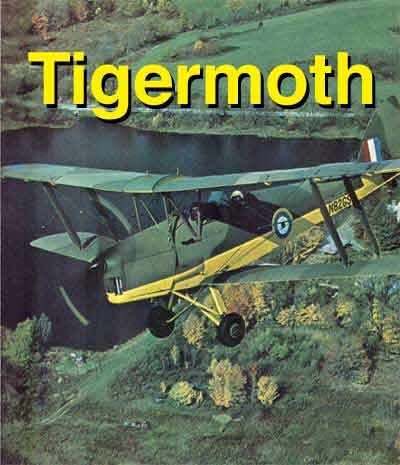
We Fly Britain's Answer to the Stearman and Like What we Find |
 |
|
Mapleseed slow
and as traditional as Britain |
An antique the day it was born, old man de Havilland's line of Moths goes clear back to the 1920s, a time in which they were on a par with their peers. However, as their peers advanced, the Moths continued to come from the cocoons with only minor mutations. Maybe a cowl line here, an engine mod there, but no sweeping design change. It's a fact that, other than its tubing fuselage (rather than wood), almost all of the structural aspects of the Tiger Moth are identical with the Gypsy and other Moths of a decade before. It was as if de Havilland was striving to reflect the British practice of "progress without change" that characterized much of the twenties and thirties.
The Tiger Moth is a true period piece. Even though Schwam's Moth is 1943vintage, a casual perusal of its bones will give the observer a lesson in state of the art engineering circa 1925. Aeroplane engineering had not separated from its much older cousin, civil engineering, so nearly every number, fitting and wire in the Moth, had its roots somehow connected with the beam and girders of your garden variety road bridge. It is a triangulated sculpture in which wires and fittings serve as tension-laden ligaments tying together femurs of spruce. While sophistication may not be the Tiger Moth's strong suit, functionalism, a la Rube Goldberg, is. For instance, rather than a finely designed pedal arrangement for the rudder, which would require separate mounts, cable runs, fittings, etc., the Math uses a true rudder bar. It's just a bar pivoted in the middle with a cable and a foot on each end. It looks crude and your feet travel in a little circle when going full travel with the rudder, but it works! The control cables run in and out of surfaces and fuselage like rubber bands energizing an erector set toy. They are everywhere, their turn-buckles and pulleys festooning every nook and cranny. Ugly, maybe. Easy to inspect, absolutely! To enter the cockpit, you reach inside and open the little wooden side doors which make it easy to clamber over the gunwhales and down into the relatively narrowcockpit. One of the funkier aspects of the Moth is that the mag switches are outside the cockpit, mounted on the left side of the fuselage between the cockpits (don't ask, I don't know why, maybe so the instructor in the front seat can reach them). The cast bronze windshield frame, however, speaks of a time when materials were much less expensive. The altimeter marked in meters speaks of a place a hell of a long way from New Jersey, and the horizontal floating compass betrays its nautical heritage. It's hard to believe this was England's finest for 1943. “. . . Even the slightest turn or The starter seemed truly out of place in such a machine. I mean, being able to throw a switch and have the motor obediently pop into life just doesn't seem right. It, however, is much easier than trying to find somebody to prop you, especially these days. Anyway, with the 130-horse Gypsy Major up front puttering away for all it's worth, I S-turned my way out to the end of the runway feeling out the tailwheel as I did. While doing this I wondered how the airplane must have handled with its original tailskid. S-turning must have been almost impossible which explains all the old pictures of Moths taxiing with the pilot hanging half way out the door on either side trying to see what was ahead.
Lined up on the grass, I eased the thrust lever forward and was greeted by more noise than anything else. We started rolling as my throttle hand moved forward, but there was no real sensation of acceleration. Just tranquil movement. Then, just after I eased the tail up, the airplane gently lifted off the grass. What I had experienced was not a takeoff, but a true lift-off. We hadn't rolled a half a dozen airplane lengths, it seemed, when the airplane reached its buoyancy balance and became a lighter-than-air craft bound for somewhere up. But not very quickly. I glanced at the airspeed and nearly panicked because the needle had hardly gotten off the peg. I knew the Handley Page slats on the wings came out about 6 knots over Vso, and they weren't out, so I was probably okay, but I pushed the nose over anyway for a more comfortable speed, around 55 knots (!) for a climb out, such as it was. I have tried several times to pick a single word to describe the Tiger Moth and several come very close. "Flaccid" was one of the first that came to mind. The airplane is limp, imprecise and soft in all its movement. It does nothing fast, especially climb and is prone to momentary lapses where it seems to wander off into another dimension. But, accurate though "flaccid" may be, it carries an uncomplimentary connotation not necessarily be-fitting of the Moth. I finally opted for the word "leisurely." The Moth is in absolutely no hurry. It doesn't feel a need to suddenly duck a wing at your command or go punching through thermals or shears. It just wafts along enjoyinthe scenery and the currents of air, going more or less where they take it, so long as the general direction agrees with the wishes of the pilot. The hand at the stick may suggest the direction but the airplane decides the exact flight path. ".. In
a few short minutes I stepped from the world of fire and |